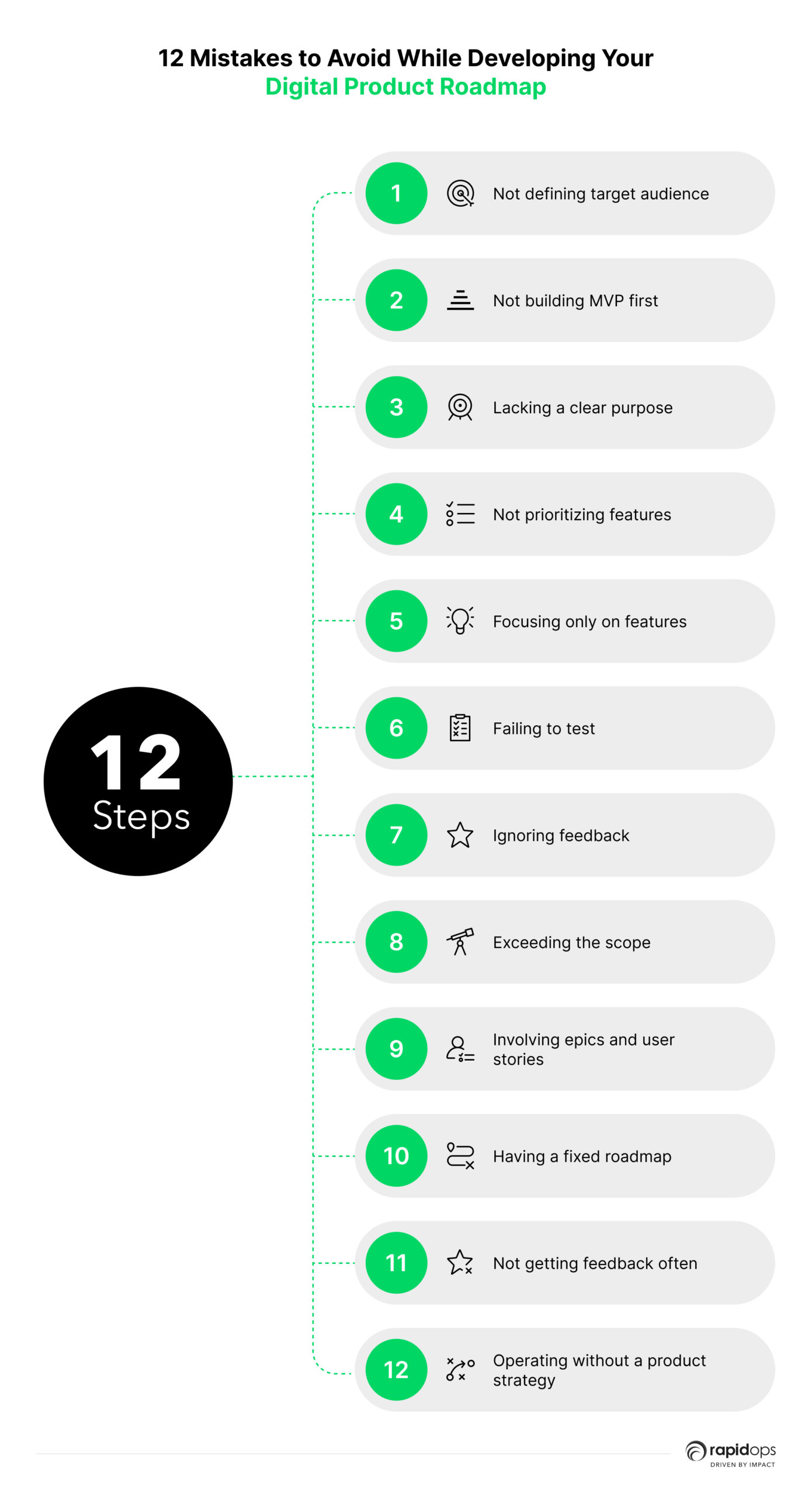If you're building a digital product, you want to ensure it sells. Often, such a feat is impossible without countering a few roadblocks. However, you must avoid making common mistakes in your digital product roadmap to avoid roadblocks.
Some of the most common mistakes that product teams make include:
- Not aligning their digital product roadmap with their business goals
- Not building a minimum viable product (MVP) first
- Overbuilding features and functionality
- Not getting feedback from customers early and often
12 Mistakes to avoid while developing your digital product roadmap
We've compiled a list to help you understand what roadblocks might creep up during digital product roadmap development. This list comprises some common missteps made while developing a digital product roadmap.
So read on and learn what not to while building a product that sells.

1. Not defining your target audience
The first mistake is failing to define your target audience.
- It's essential to understand who you're building the product for.
- Otherwise, you risk developing something that doesn't appeal to anyone.
- Many teams think they can build a product for everyone – but this is rarely the case.
- It's much better to focus on a specific group of people and create something that perfectly meets their needs.
2. Not building a minimum viable product (MVP) first
When planning your product roadmap, it's essential that you think about the minimum viable product. This is the bare minimum you need to create to get feedback from users and customers.
- Too often, product teams get caught up in adding unnecessary features and bells and whistles.
- They need to get a functioning product out the door quickly.
- Your MVP doesn't have to be perfect; it doesn't have all the features you eventually want to include.
- It just needs to be good enough to get feedback from real users so that you can iterate and improve upon it.
Please don't fall into the trap of thinking that your product needs to be perfect before releasing it.
3. Lacking a clear purpose
Another common mistake is lacking a clear purpose for the product.
- Before starting development, it's essential to know what the product is supposed to achieve.
- Otherwise, you'll likely have a few features that don't fit together.
- Ensuring everyone on the team understands the product's purpose is also essential.
- This will help ensure everyone is working towards the same goal and avoid further confusion.
4. Not prioritizing features
Once you've defined the product's purpose, it's time to consider which features to include.
- This can be a difficult task, as there are often many different ideas floating around—and it's tempting to try to have them all.
- However, it's vital to prioritize features and only include the essential ones.
- Trying to cram in too many features will make the product more complicated and harder to use.
5. Focusing on features instead of solutions
You don't want to become "the next feature factory." The most important thing when trying to market your product is that it solves people's problems.
You should consider solutions rather than features since this will help your product roadmap stay focused.
If you focus too much on features rather than solutions, you may not have well-defined product goals.
Equally, prioritizing features before developing solutions will make you less likely to meet essential client requirements.
The ideal approach is to think about your objectives and build a roadmap based on them:
- What are your product's goals?
- What problems is it trying to address?
- How exactly is it addressing these problems?
This is another indication that you're headed in the right direction.
6. Failing to test
Another common mistake is failing to test the product before launch. This is a crucial step in the development process. It allows you to catch any potential problems and ensure that the product is fit for purpose.
Testing can be done in many ways, such as user or A/B testing.
It is critical to choose a suitable method for your product and ensure that tests are carried out at regular intervals throughout the development process.
7. Ignoring feedback
One of the most common mistakes is ignoring feedback from users and customers. This feedback is essential in helping you improve the product and ensure it meets people's needs.
Of course, it's not always possible to please everyone. However, it's important to at least listen to what people are saying and take their feedback.
Avoiding these mistakes will help you develop a product roadmap that will likely result in a product that sells.
8. Exceeding the scope
One of the most frequent blunders is to include too much information in the product plan.
Many executives are too detailed. They have
- all of their planned feature development
- anticipated timeframes
- resources in their product roadmap
These specifics are crucial but should not be included in a product roadmap.
A roadmap is intended to be a high-level, long-term plan.
- It should represent the product team's vision and convert it into themes that cross-functional teams can address.
- The ideal technique is to keep things straightforward and strategic.
- Product roadmaps become less helpful when they get clogged with excessive information at each process step.
- Keep them simple if you want a clear strategic vision.
9. Involving epics and user stories
The finest roadmaps give a broad overview of what will happen with your product or feature shortly. On the other hand, many executives disregard the fundamental aim of a roadmap and start including complex epics and even user stories into it.
- It is rarely the case that you can create a strategic vision for a product by looking at soft data.
- If you want to generate a vision for your product, think about actual facts and clear strategic thinking.
- User stories will make the product roadmap harder to understand and concise.
- It'll be tough to read, and the big picture will get lost in irrelevant details.
- The ideal approach includes these epics and user stories in the backlog.
- They will not fit into a roadmap presentation's purpose in most situations.
- Conversely, user stories and epics will be important data points beyond the scope of the roadmap.
10. Having a fixed roadmap
The development of a roadmap should not be halted or frozen once produced.
It's not the sort of document we ideate, classify, describe, convey, cross things off of lists, and then forget about. It is critical to keep an eye on it at all times.
We frequently witness businesses working on their roadmaps in the first part of the year, then losing interest midway through.
They don't make any adjustments, resulting in difficulties as the product develops throughout design and development.
- A product roadmap is a strategic forecast for your products and should reflect present conditions and micro and macro ecosystems.
- It's best to revisit it at least once a quarter.
- This will give you the most excellent chance of creating a product roadmap relevant to your current goals.
- It will also be capable of envisioning future events or changes.
11. Not getting feedback from users early and often
Another common mistake when building a product roadmap is not getting user feedback early and often enough.
- Getting feedback at every stage of the product development process is important to course-correct it if necessary.
- Don't wait until your product is finished to get feedback.
- Get feedback from potential users as early as possible, even if you only have a rough prototype.
- The sooner you get feedback, the better. So, it is always a smart decision to use an AI survey generator to collect feedback faster.
12. Operating without a product strategy
A product roadmap is a strategic visual tool. Without a strong product strategy, your roadmap planning tool will become unclear and aimless.
Conversely, a product strategy can be challenging if you lack a core concept that binds everything together.
If you don't have a digital product strategy, put off creating a product roadmap.
Strategy is more important than a product roadmap, so make sure you have one before drawing your roadmap.
Concluding thoughts: A practical roadmap is the key to a successful product
If you have a clear idea, are prepared to change it over time, and are willing to make the process collaborative, you'll be far less likely to make these product roadmap blunders.
Complex data, product knowledge, and strategic thinking are essential to the best product roadmaps.
Indeed, there will be potholes along the way, but we feel that if you avoid these twelve common blunders, you'll be able to construct an excellent product roadmap. Remember, building an effective digital product roadmap is key to creating a first-class digital product.

Saptarshi Das
Content Editor
9+ years of expertise in content marketing, SEO, and SERP research. Creates informative, engaging content to achieve marketing goals. Empathetic approach and deep understanding of target audience needs. Expert in SEO optimization for maximum visibility. Your ideal content marketing strategist.

Let’s build the next big thing!
Share your ideas and vision with us to explore your digital opportunities
Similar Stories
- Strategy
- undefined Mins
- February 2017

- Strategy
- 19 Mins
- August 2023


Receive articles like this in your mailbox
Sign up to get weekly insights & inspiration in your inbox.

